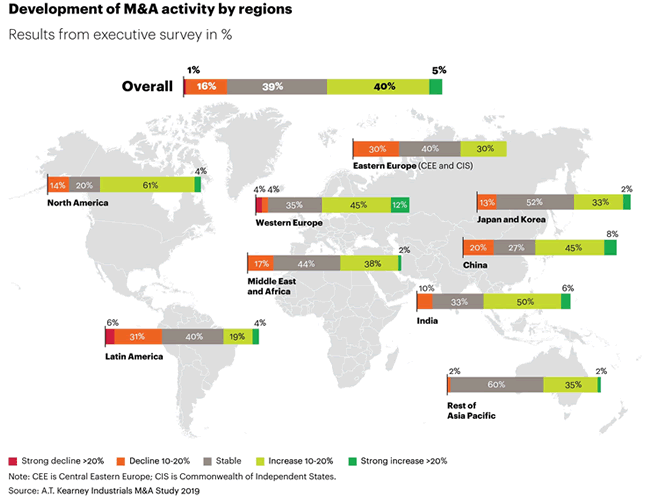Technology access is the main driver of industrials M&A (mergers and acquisitions) activity, followed by consolidation within sectors and ‘market and competitive environment’.
These are some of the findings from consulting firm A.T. Kearney’s 2019 Industrials Executive M&A Report, announced early April 2019. According to the report consolidation and digital transformation are poised to continue to drive a wave of mergers in 2019.
Access to technologies obviously is important in today’s business context where large organizations across several sectors need to respond to fast-changing market realities with fierce competition, ongoing digitalization, economic challenges and changing demands from customers and ecosystem partners. As A.T. Kearney puts it: the impact of digitization is felt broadly across the business landscape.
On top of digitization, consolidation is a second key factor driving industrials to engage in takeovers and mergers A.T. Kearney says. While digitization and consolidation are the drivers, the M&A activity could be slowed down by a well-known factor as was the case in previous years: political and regulatory interventions (recent example: the EU and the Alstom–Siemens deal).
Strong outlook for industrials M&A in 2019 and beyond with automotive and electronics industry to watch
According to the report automotive is one of the industries to watch in 2019 and beyond. This is probably not that much of a surprise, given the many simultaneous evolutions in an industry where organizations have the need – and means – to digitize and digitalize through deals within and outside of their segment.
On top of the need for digital transformation in this particularly technology-intensive industry, the necessity to transform value chains in these days of Industry 4.0 and the need to achieve economies of scale are essential. With transformation and economies of scale, through consolidation, as drivers it’s clear that expected M&A activity in automotive will lead to both sector-internal and cross-sector deals. New technologies such as electric propulsion and autonomous driving are cited as additional reasons for deals in the automotive sector.
The second industry to watch in 2019 according to the findings of the Industrials Executive M&A Report 2019 is the electronics industry.
Here especially semiconductor companies have been – and will remain – active. Examples mentioned by A.T. Kearney for 2018 include the acquisitions of Microsemi by Microchip, Cavium by Marvell and Siliconware Precision Industries by Advanced Semiconductor Engineering.
More industries where consolidation is expected to continue – such as aerospace – on the overview page of the Industrials Executive M&A Report 2019.
M&A activity from the regional and cross-border perspective
All in all, A.T. Kearney says, the outlook for 2019 remains strong for industrials M&A in 2019. Quote: “The backlog of deals already amounts to more than $90 billion for the top 10 deals and more than $300 billion overall.”
Looking back at 2018, the total value of deals completed rose to $680 billion in 2018 (up from $662 billion in 2017). The chart below shows the development of M&A activity by regions in percentage as found in the executive survey.

That brings us to the regional perspective which shows that in 2018, the US again led the global industrials M&A market with transactions worth $282 billion. Guido Hertel, partner at A.T. Kearney, expects the M&A market to continue to grow in North America and Western Europe, as well as in the emerging markets of China and India this year and beyond.
Although most M&A deals occur within a country there are some large cross-border deals on the horizon the Industrials Executive M&A Report reminds. We’ve mentioned some previously and it’s probably not a coincidence many are in the space of Industry 4.0 and the technologies required for a strong end-to-end industrial offering.
Examples include the planned acquisition of the power grid division of ABB by Hitachi and the acquisition of IT security leader Gemalto by French Thales group.
The digitalization of business models is visible in several cross-sector M&A activities with more to be expected. Here, A.T. Kearney, among others, mentions Broadcom’s 2018 acquisition of CA Technologies and the investment of some automotive OEMs in mobility service providers with Toyota’s investment in GrabTaxi as an example.
A sector that, despite its focus on Industry 4.0 and the Internet of Things (IoT) isn’t driven by M&A (yet) is the machinery sector. Here A.T. Kearney expects ‘less disruptive‘ approaches for players to develop the digital competencies they need.
Obviously all this M&A activity, digital transformation and consolidation serve multiple goals, not in the least better meeting demands of customers.
A.T. Kearney mentions some examples of 2018 deals across various industries showing that being close to the customer and customer intimacy are driving downstream integration. Think about the merger (or acquisition) of the industrial software business of Schneider Electric with AVEVA or the acquisition of Mendix by Siemens in order to enable app development (application enablement as it’s called in the IoT industry) in its IIoT platform MindSphere.
More findings from the report in the press release and on the report landing page. A.T. Kearney’s 2019 Industrials Executive M&A Report can be downloaded here.

